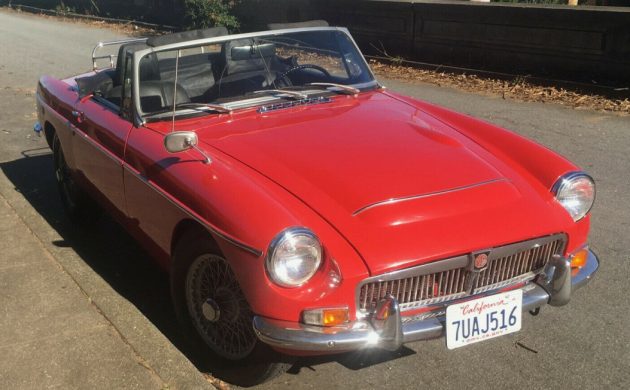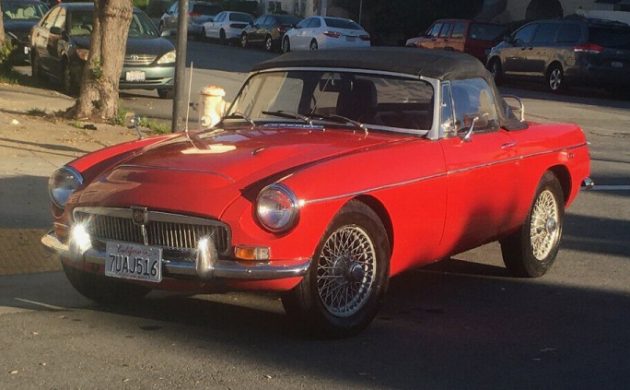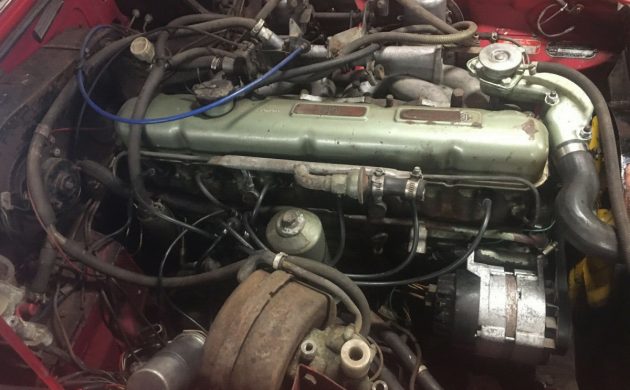Although it might seem familiar at first glance, this is one of the most rare British sports cars ever to hit American shores. This 1969 MGC convertible is one of only 1,757 produced in Abingdon that year. Located in San Francisco and listed here on eBay, it has attracted only a single bid thus far. At the time of writing, the price rests at $10,000, with only one day left before the auction ends.
If you were to look up “British sports car” in the dictionary, the picture right next to it would be the MGB. With just under four hundred thousand produced between 1962 and 1980, it was the most popular roadster ever produced before the advent of the MX-5. But setting aside the exceptional handling and the attractive price tag, there was the engine. While the 1,798 cc inline-4 was, at 95 brake horses, competitive with other offerings in its class in the mid-60s, by the second half of the decade other manufacturers had begun to adopt six-cylinder powerplants.
On the other hand, BMC had recently hit one out of the park with the MG Midget, a badge-engineered version of the second-generation Austin-Healey Sprite. With management looking to cut costs while meeting evolving US safety regulations, the MG platform was proposed as the basis for the replacement for the Austin-Healey 3000. Since no heir to the Big Healey could ever sport a four-banger, the hood was granted a bulge, and then another, and the MGC was born; a car so incredible that Donald Healey flatly refused to be associated with it. Which ultimately meant that the Austin-Healeys would continue to be sold alongside the new model.
The inline-six chosen for the MGC was a 2.9L unit also used in the Austin 3-Litre saloon. Producing a little under 150 hp at 5,250 rpm, it propelled the new car from zero to sixty in ten seconds flat and gave it a top speed of 120 mph. Larger brakes, an upgraded suspension, and alterations to the steering completed the package and the MGC was released to… very bad reviews, since the additional weight up front drastically altered the balance of the car. BMC claimed that the press cars’ tires were to blame, but the damage was done. The last MGC would roll out of the Abingdon factory in 1969, less than two years after the model’s launch.
This example is represented as a well-maintained driver, with no known accidents and an odometer resting at 57,000 miles. The underside of the car looks very clean and the seller plans to address the only rust visible in the pictures. Presented with no reserve, and with a seller apparently willing to facilitate shipping, it’s possible that this rare machine may go for a bargain price– though where it might go is anyone’s guess.





Had a 69 convertible in that same color. Did a double take when I saw this. Can’t even fathom spending as much time and money on keeping a car running now as I did then. Eventually bored it 60 over, added a 3/4 race cam, third carb and water injection. Fun while it lasted.
Is that a cruise control mechanism on the passenger side inner fender? That is a whole lot of vacuum lines and individual wires in the engine compartment to sort out. The buyer will have a ball with this car! It’s a unique ride.
That’s a remote vacuum brake booster. Fairly common at the time due to no room for it at the brake master cylinder.
Typical British car hose and wiring mess under the hood, what a kluster.
The other picture on eBay with a nicely sorted engine bay is a good guide for how it should really look.
Yeah, just saw the photo of what it could/should look like.
There are 2 remote boosters-both apparently bypassed in this car.
Cruise control? LOL… that automotive black magic was science fiction when they built these bruises
No, that is not true. I recall a dial shaped device on Cadillac in 1962, on the right of the speedo. Cruise and throttle control was experimented with by many throughout history. It just wasn’t very common.
two hours + to go…now at $10,200. A very sharp sport car and I wish I had a garage for it… Best to seller and new owner !
The vacuum device is the remote brake booster. Its to clear it from the exhaust manifol. Its not so easy to make a RHD into a LHD (in the factory).
When selling 80% LHD the british still managed after many years to conceive RHD and convert them them to LHD at great manufacturing expenses. Wiring looms, etc everything less practical in manufacturing. But still great cars. I often wonder, after looking into modern contraptions with added vibration dampers and added anti vibration masses how good would be a E (Type).
regards from snowy Tyrol
Wonder why the back end is jacked up so high…
I’ve only seen one MGC back in the mid-1970s. It was in the back lot of a body shop probably destined for the scrap yard. It had been backed over by a garbage truck and deemed totaled. Probably repairable in the right hands but in those days, it was just another troublesome British sports car not worth the effort. Ouch!